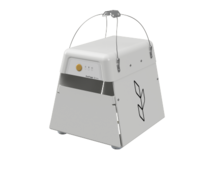Agricultural technology
This article needs additional citations for verification. (December 2020) |
| Agriculture |
|---|
 |
|
|
Agricultural technology or agrotechnology (abbreviated agtech, agritech, AgriTech, or agrotech) is the use of technology in agriculture, horticulture, and aquaculture with the aim of improving yield, efficiency, and profitability. Agricultural technology can be products, services or applications derived from agriculture that improve various input/output processes.[1][2]
Advances in agricultural science, agronomy, and agricultural engineering have led to applied developments in agricultural technology.[3][4]
History
This section needs expansion. You can help by adding to it. (November 2020) |
The history of agriculture has been shaped by technological advances. Agricultural technology dates back thousands of years. Historians have described a number of agricultural revolutions, which identify major shifts in agricultural practice and productivity. These revolutions have been closely connected to technological improvements.
Around 10,000 years ago, the
The
The
A major turning point for agricultural technology is the Industrial Revolution, which introduced agricultural machinery to mechanise the labour of agriculture, greatly increasing farm worker productivity. Revolutionary inventions like the seed drill, mechanical reaper, and steam-powered tractors reshaped the farming landscape. This period also witnessed the establishment of agricultural societies and colleges dedicated to advancing farming methodologies. In modern mechanised agriculture powered machinery has replaced many farm jobs formerly carried out by manual labour or by working animals such as oxen, horses and mules.
Advances in the 19th century included the development of modern
The 20th century saw major advances in agricultural technologies, including the development of synthetic fertilizers and pesticides, and new agricultural machinery including mass produced tractors and agricultural aircraft for aerial application of pesticides. More recent advances have included agricultural plastics, genetically modified crops, improved drip irrigation, integrated pest management, and soilless farming techniques such as hydroponics, aquaponics, and aeroponics.
In the first decades of the 21st century, Information Age technologies have been increasingly applied to agriculture. Agricultural robots, agricultural drones and driverless tractors have found regular use on farms, while digital agriculture and precision agriculture make use of extensive data collection and computation to improve farm efficiency.[7] Precision agriculture includes such areas as precision beekeeping, precision livestock farming, and precision viticulture.
Modern Agricultural Technology Tools
Climate Monitoring
- Weather forecasting
- IoT-based Sensors Networks
Nutrition Management
- Digital Soil Analysis Devices
- Soil moisture sensors

Irrigation Management
- Automated irrigation
- Irrigation Recommendations
Pest and Disease Management
- Digital Pheromone Traps

PestTrapp Digital Pest Tracking Station
Crop Inspection
Farm Management
- Farm Management System
Hydroponics
Hydroponics is a method of cultivating plants without soil. Instead, it relies on a nutrient-rich water solution to deliver essential minerals and nutrients directly to the plant roots. This approach allows for precise control over growing conditions and can lead to increased crop yields and faster growth rates.
Vertical Farming
Vertical farming is a contemporary agricultural technique that cultivates crops in vertically stacked layers or inclined surfaces within controlled indoor settings. This innovative approach leverages technology and controlled environments to enhance crop growth.[8]
Agricultural Drones
Agricultural drones, also known as "ag drones," are specialized unmanned aerial vehicles (UAVs) or remotely piloted aircraft systems (RPAS) tailored for agricultural applications. These drones are outfitted with an array of sensors, cameras, and advanced technology to aid in agricultural and land management tasks. Their purposes encompass crop monitoring, efficient irrigation management, early pest and disease detection, precise crop spraying, and detailed crop mapping, among others.
Agro-textiles
Agro-textiles is the segmented class of
More technologies and applications
- Bird control
- Bird netting
- Satellite photography and sensors
- Phase tracking
- Light and heat control
- Soil management and other involved analytical tasks
- Biotech
See also
- Agricultural aircraft – Category of Aircraft
- Agricultural engineering – Application of engineering for agricultural purposes
- Agricultural machinery – Machinery used in farming or other agriculture
- Atomic gardening – Form of mutation breeding in plants
- Automatic milking – Milking of dairy animals without human labour
- Controlled-environment agriculture – Technology-based approach toward food growing
- Data mining in agriculture – Application of data mining techniques to agriculture
- Food technology – Academic discipline regarding the preparation of foods
- Information and communications technology in agriculture – Agricultural and rural development
- Optical sorting – Automated sorting of solid products using cameras and/or lasers.
- Plasticulture – Use of plastic materials in agriculture
- Technology and society – Overview of the relationship between technology and society
- Timeline of cellular agriculture
References
- ^ "Agriculture Technology | National Institute of Food and Agriculture". nifa.usda.gov. Retrieved 2020-12-23.
- ^ "Agricultural technology". Encyclopedia Britannica. Retrieved 2020-12-23.
- ^ "Agricultural Technology Center > Agricultural Technology Center". english.busan.go.kr. Retrieved 2020-12-23.
- ^ "The evolution of agricultural technology". Innovation News Network. 2020-07-08. Retrieved 2020-12-23.
- ^
ISBN 9780202365572. Retrieved 2019-01-12.
- ^
Lawton, H. W.; Wilke, P. J. (1979). "Ancient Agricultural Systems in Dry Regions of the Old World". In Hall, A. E.; Cannell, G. H.; Lawton, H.W. (eds.). Agriculture in Semi-Arid Environments. Ecological Studies. Vol. 34 (reprint ed.). Berlin: Springer Science & Business Media (published 2012). p. 13. ISBN 9783642673283. Retrieved 2019-01-12.
- ^ "Agricultural Technology - an overview | ScienceDirect Topics". www.sciencedirect.com. Retrieved 2020-12-23.
- ^ Birkby, Jeff (January 2016). "Vertical Farming". ATTRA Sustainable Agriculture Program. Retrieved 6 February 2022.
- ISBN 978-93-85059-89-6.

